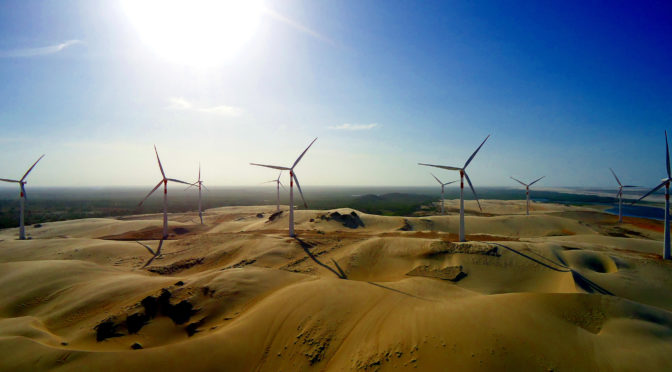One of the factors that helps in the development process of the wind sector is the decarbonization of energy matrices and the search for renewable solutions.
The generation of wind energy, a source of renewable and sustainable energy, had important milestones this year in Brazil, highlighting the approval in the Chamber of the legal framework for offshore wind plants, that is, wind turbines located on the high seas – which demonstrates the growth of this market.
Elbia Gannoum, executive president of the Brazilian Association of Wind Energy and New Technologies (ABEEólica), explains that, in 2011, the first wind farms were installed in Brazil and, since then, there has been progress.
“Wind energy has grown exponentially. And in the last three years, we have broken record after record in wind farm installations. In 2017, wind energy became the cheapest source of energy, surpassing even hydroelectric plants,” says Gannoum.
2023 was a great year for this type of energy. According to ABEEólica, 109 new wind farms were installed in Brazil this year, with a total of 4.05 GW (gigawatts) of new capacity. The states with the highest number of new parks are: Bahía (BA), Piauí (PI), Rio Grande do Norte (RN), Pernambuco (PE), Paraíba (PB) and Ceará (CE).
“Today, wind energy – along with solar – is the fastest growing and is understood as a response to the energy transition both from a global point of view and also from the Brazilian point of view,” says Gannoum. The executive president of the organization explains that, in 2018, wind energy had a capacity of 2 GW (gigawatts) and this year, the market closed the period reaching the mark of 4.4 GW of installed capacity.
One of the factors that helps in the development process of the sector is the decarbonization of energy matrices and the search for renewable solutions, where industries seek to adapt their production processes to new demands. And wind energy has proven to be more competitive than fossil fuels, according to Gannoum.
For the president of the association, attracting more factories to invest more in energy can benefit the wind energy market, through powershore. This is the term used to refer to energy supply strategies, with the decentralization of clean, renewable and cheap energy. According to the Development Bank of Latin America and the Caribbean (CAF), the Latin American region meets many of the necessary conditions to apply powershoring.
“This places wind energy as having great potential, along with the production of green hydrogen and other renewable energies,” says Gannoum.
The difference between onshore and offshore wind energy
Onshore wind energy refers to farms located on land, while offshore wind energy is energy produced offshore, which uses open ocean winds to generate power.
Is offshore wind energy a new market trend?
According to the Brazilian Institute of Environment and Renewable Natural Resources (Ibama), 91 projects related to the installation of offshore wind farms requested an environmental license, representing approximately R$ 40 billion in investments for installation and logistics.
If implemented, the new parks could generate more than 189 GigaWatts (GW). Ibama that until September 15, another 13 projects had been registered, 10 of them from Petrobras, which entered the offshore wind sector.
Petrobras’ investment with WEG focuses on the development of wind turbines within the framework of agreements with Casa dos Ventos and Total Energies. This move by the state-owned company is part of the company’s investment in diversifying its products beyond fossil fuels, focusing on the energy transition. “Petrobras assumes the position of the largest developer of wind energy projects in Brazil. The company has arrived,” summarized Jean Paul Prates, president of the state company.
According to data from the National Confederation of Industry (CNI), offshore wind energy has an energy potential of around 700 gigawatts (GW), which could increase the energy capacity already installed in Brazil by 3.6 times.
The social relevance of the matrix
Another important point is how wind energy connects with the socio-economic development area of ??ESG (environmental, social and governance). “Wind energy is abundant in the country and has an important social aspect. It provides employment and income to the population where the parks are installed. Today, more than 90% of the projects are installed in the Northeast and we carried out a study that showed that for every R$1 invested in wind energy, R$2.9 is returned to the economy, so this effect in terms of the GDP has a very considerable multiplier effect,” says Gannoum.


